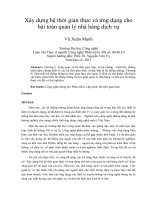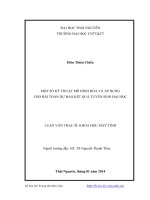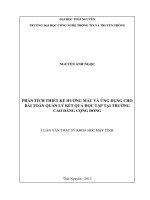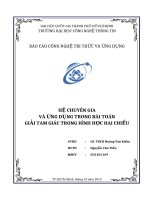DSpace at VNU: Hệ tư vấn và ứng dụng cho bài toán dự báo kết quả bóng đá
Bạn đang xem bản rút gọn của tài liệu. Xem và tải ngay bản đầy đủ của tài liệu tại đây (225.67 KB, 4 trang )
Hệ tư vấn và ứng dụng cho bài toán dự báo
kết quả bóng đá
Nguyễn Thị Ninh
Trường Đại học Công nghệ
Luận văn ThS. Công nghệ thông tin; Mã số: 60480104
Người hướng dẫn: PGS.TS. Nguyễn Đình Hóa, TS. Lê Hoàng Sơn
Năm bảo vệ: 2014
Abstract. Hệ tư vấn đã và đang được ứng dụng rất nhiều trong các lĩnh vực của cuộc
sống để đưa ra khuyến nghị cho người dùng khi cần tìm kiếm, đánh giá thông tin. Trên cơ
sở đó, luận văn đã trình bày và đạt được kết quả như sau:
Về mặt lý thuyết, tổng quan được kiến thức cơ bản về khai phá thông tin. Tổng quan về
hệ tư vấn và các phương pháp lọc. Độ đo tương tự NHSM.
Về mặt ứng dụng, triển khai thuật toán lọc cộng tác với độ đo NHSM cho bài toán dự báo
kết quả bóng đá.
Keywords. Hệ tư vấn; Hệ thống thông tin; Công nghệ thông tin
Content.
Chương 1: Tổng quan về khai phá dữ liệu
Trong chương này, luận văn sẽ trình bày những vấn đề cơ bản của khai phá dữ liệu như:
định nghĩa, các thành tố cơ bản của một nhiệm vụ khai phá dữ liệu, các nhiệm vụ, các kỹ thuật
và ứng dụng của khai phá dữ liệu. Thông qua đó, khai phá dữ liệu tạo đã điều kiện phát triển cho
hệ tư vấn.
Chương 2: Hệ tư vấn và các phương pháp lọc
Phần đầu tiên giới thiệu là các thông tin liên quan đến hệ tư vấn: định nghĩa và phương
pháp khuyến nghị lọc cộng tác.
Vấn đề thứ hai được trình bày trong chương này là vấn đề cold - start nảy sinh và phương
pháp khắc phục dựa trên tính nhân khẩu. Nội dung phần này cũng trình bày cụ thể vai trò của
ngữ cảnh cùng sự xuất hiện của phương pháp tiếp cận đa chiều trong khuyến nghị.
Phần tiếp theo trình bày về các độ đo tương tự. Đưa ra độ đo tương tự mới NHSM và thuật
toán dự báo kết quả bóng đá với độ đo mới này.
Chương 3: Ứng dụng cho bài toán dự báo kết quả bóng đá
Nội dung chương này trình bày phân tích, thiết kế trang web dự báo kết quả bóng đá và
xây dựng chương trình ứng dụng.
References.
Tiếng Việt
[1] Nguyễn Đức Cường (2011), Tổng quan về khai phá dữ liệu, Khoa Công nghệ Thông tin,
Đại học Bách Khoa TPHCM.
[2] Đỗ Phúc (2005), Giáo trình Khai thác dữ liệu, ĐHQG TPHCM.
[3] Nguyễn Nhật Quang (2010), Khai phá dữ liệu, Viện Công nghệ Thông tin và Truyền
thông, Đại học Bách Khoa Hà Nội.
[4] Hà Quang Thụy (2011), Bài giảng nhập môn khai phá dữ liệu, Đại học Công nghệ,
ĐHQGHN.
Tiếng Anh
[1] Abdelwahab A., Sekiya H., Matsuba I., Horiuchi Y., Kuroiwa S. (2009), Collaborative
filtering based on an iterative prediction method to alleviate the sparsity problem, in:
Proceedings of the International Conference on Information Integration and Web-based
Applications & Services, pp. 375–379.
[2] Adomavicius G., R. Sankaranarayanan, S. Sen and A. Tuzhilin (2005), “Incorporating
contextual information in recommender systems using a multidimensional approach”,
ACM Transactions on Information Systems (TOIS), 23(1), pp. 103-145.
[3] Adomavicius G., Tuzhilin, A. (2005), “Toward the next generation of recommender
systems: A survey of the state-of-the-art and possible extensions”, Knowledge and Data
Engineering, IEEE Transactions on, 17(6), 734-749.
[4] Adomavicius G., Tuzhilin, A. (2011), “Context-aware recommender systems”, In
Recommender systems handbook, pp. 217-253.
[5] Ahn H.J. (2008), A new similarity measure for collaborative filtering to alleviate the
new user cold-starting problem, Inform. Sci. 178 (1), pp. 37–51
[6] Anand D., Bharadwaj K.K. (2011), Utilizing various sparsity measures for enhancing
accuracy of collaborative recommender systems based on local and global similarities,
Expert Syst. Appl. 38, pp. 5101–5109.
[7] Bobadilla J., Ortega F., Hernando A., Bernal J. (2011), A collaborative filtering
approach to mitigate the new user cold start problem, Knowledge-Based Syst. 26, pp.
225–238.
[8] Bryan K., O'Mahony M. and Cunningham P. (2008), “Unsupervised retrieval of attack
profiles in collaborative recommender systems”, Proceedings of the 2008 ACM
conference on Recommender systems, pp. 155-162.
[9] Cacheda F., Carneiro V., Fernández D., Formoso V. (2011), Comparison of
collaborative filtering algorithms: limitations of current techniques and proposals for
scalable, high-performance recommender system, ACM Trans. Web 5 (1), pp. 1–33.
[10] DanEr C. (2009), The collaborative filtering recommendation algorithm based on BP
neural networks, in: Proceedings of the International Symposium on Intelligent
Ubiquitous Computing and Education, pp. 234–236.
[11] Fayyad U., Piatetsky-Shapiro G. and Smyth P. (1996), “From data mining to
knowledge discovery in databases”, AI magazine, 17(3), pp. 37.
[12] Fu Y. (1997), Data mining: Tasks, techniques and applications, Department of
Computer Science, University of Missouri-Rolla.
[13] Han J., Fu Y., Wang W., Koperski K. and Zaiane O. (1996), “DMQL: A data mining
query language for relational databases”, Proc. 1996 SiGMOD, 96, pp. 27-34.
[14] Hand D. J., Mannila H. and Smyth P. (2001), Principles of data mining, MIT press. Ho
T. B. (2002), Introduction to knowledge discovery and data mining, National Center for
Natural Science and Technology.
[15] Han J., Kamber M. (2001), Data Mining: Concepts and Techniques, Morgan
Kaufmann.
[16] Han J., Kamber M. and Pei J. (2006), Data mining: concepts and techniques, Morgan
kaufmann.
[17] Han J., Kamber M. and Pei J. (2011), Data mining: concepts and techniques, Elsevier.
[18] Hao M., King I., Michael R.I. (2007), Effective missing data prediction for
collaborative filtering, in: Proceedings of the Annual International ACM SIGIR
Conference on Research and Development in Information Retrieval, pp. 39–46.
[19] Hao M., Haixuan Y., Lyu M.R., Irwin K. (2008), Sorec: social recommendation using
probabilistic matrix factorization, in: Proceedings of the 17th ACM Conference on
Information and Knowledge Management, pp. 931–940.
[20] Herlocker J.L., Konstan J.A., Borchers A., Riedl J. (1999), An algorithmic framework
for performing collaborative filtering, in: Proceedings of the Annual International ACM
SIGIR Conference on Research and Development in Information Retrieval, pp. 230–
237.
[21] Jamali M., Ester M. (2009), TrustWalker: a random walk model for combining trustbased and item-based recommendation, in: Proceedings of the 15th ACM SIGKDD
International Conference on Knowledge Discovery and Data Mining, pp. 397–406.
[22] Koutrica G., Bercovitz B., Garcia H. (2009), FlexRecs: expressing and combining
flexible recommendations, in: Proceedings of the ACM SIGMOD International
Conference on Management of Data, pp. 745–758.
[23] Mobasher B., Burke R., Bhaumik R. and Williams C. (2005), “Effective attack models
for shilling item-based collaborative filtering systems”, Proceedings of the 2005
WebKDD Workshop, held in conjuction with ACM SIGKDD’2005.
[24] Haifeng L., Zheng H., Ahmad M., Hui T., Xuzhen Z., (2014), “Knowledge-Based
Systems: A new user similarity model to improve the accurary of collaborative
filtering”, pp. 5-6.
[25] Nan L., Chunping L. (2009), Zero-sum reward and punishment collaborative filtering
recommendation algorithm. in: Proceedings of the IEEE/WIC/ACM International
Conference on Web Intelligence Agent Technology, pp. 548–551.
[26] Naisbitt J. (1982), Megatrends. New York: Warner Books.
[27] O'Mahony M., Hurley N., Kushmerick N. and Silvestre G. (2004), “Collaborative
recommendation: A robustness analysis”, ACM Transactions on Internet Technology
(TOIT), 4(4), pp. 344-377.
[28] Ricci F., Rokach L. and Shapira B. (2011), Introduction to recommender systems
handbook, pp. 1-35.
[29] Resnick P., Iacovou N., Suchak M., Bergstrom P., Riedl J. (1994), GroupLens: an open
architecture for collaborative filtering of netnews, in: Proceeding of the ACM
Conference on Computer Supported Cooperative Work, pp. 175–186
[30] Shardanand U., Maes P. (1994), Social information filtering: algorithms for automating
word of mouth, in: Proceedings of the SIGCHI Conference on Human Factors in
Computing Systems, pp. 210–217.
[31] Zenebe A., Norcio A. F. (2009), “Representation, similarity measures and aggregation
methods using fuzzy sets for content-based recommender systems”, Fuzzy Sets and
Systems, 160(1), pp. 76-94.









